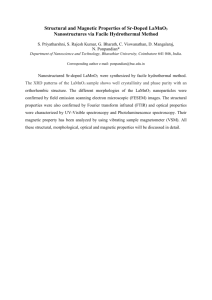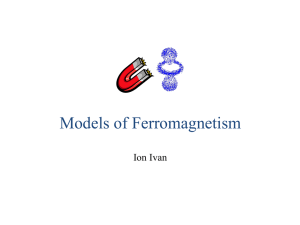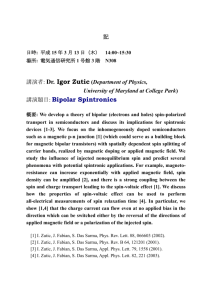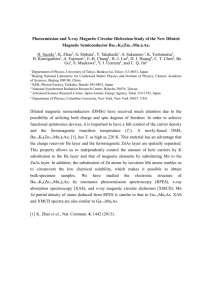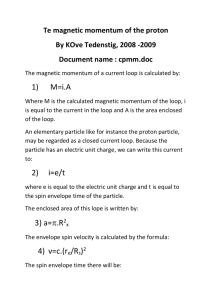Paper
advertisement
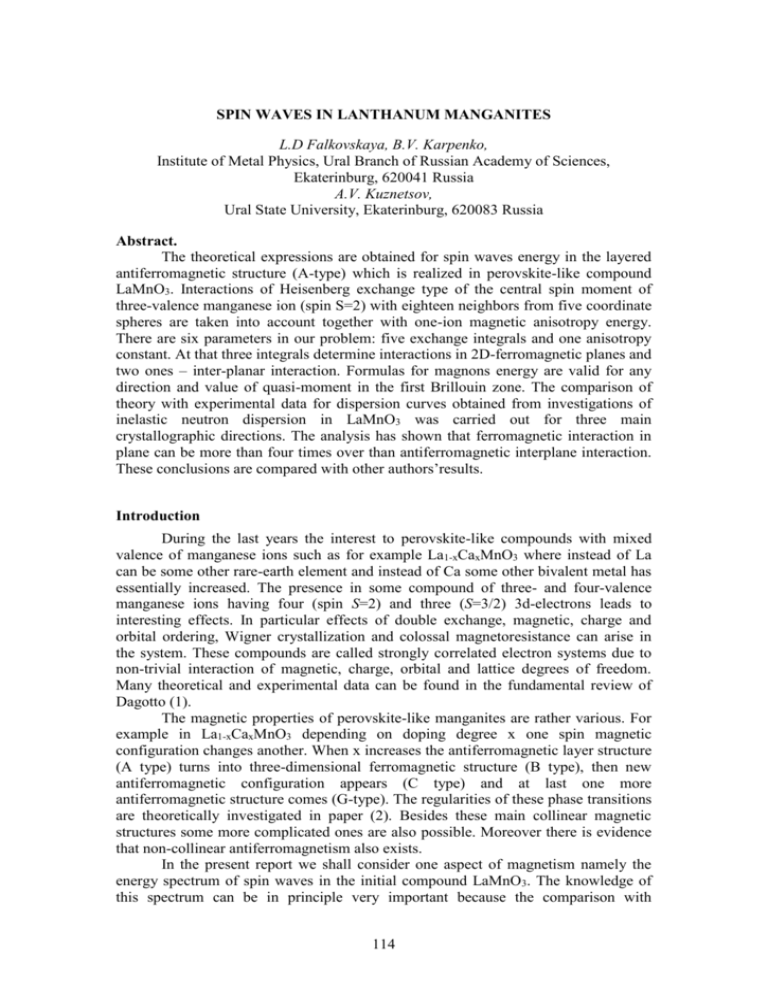
SPIN WAVES IN LANTHANUM MANGANITES L.D Falkovskaya, B.V. Karpenko, Institute of Metal Physics, Ural Branch of Russian Academy of Sciences, Ekaterinburg, 620041 Russia A.V. Kuznetsov, Ural State University, Ekaterinburg, 620083 Russia Abstract. The theoretical expressions are obtained for spin waves energy in the layered antiferromagnetic structure (A-type) which is realized in perovskite-like compound LaMnO3. Interactions of Heisenberg exchange type of the central spin moment of three-valence manganese ion (spin S=2) with eighteen neighbors from five coordinate spheres are taken into account together with one-ion magnetic anisotropy energy. There are six parameters in our problem: five exchange integrals and one anisotropy constant. At that three integrals determine interactions in 2D-ferromagnetic planes and two ones – inter-planar interaction. Formulas for magnons energy are valid for any direction and value of quasi-moment in the first Brillouin zone. The comparison of theory with experimental data for dispersion curves obtained from investigations of inelastic neutron dispersion in LaMnO3 was carried out for three main crystallographic directions. The analysis has shown that ferromagnetic interaction in plane can be more than four times over than antiferromagnetic interplane interaction. These conclusions are compared with other authors’results. Introduction During the last years the interest to perovskite-like compounds with mixed valence of manganese ions such as for example La1-xCaxMnO3 where instead of La can be some other rare-earth element and instead of Ca some other bivalent metal has essentially increased. The presence in some compound of three- and four-valence manganese ions having four (spin S=2) and three (S=3/2) 3d-electrons leads to interesting effects. In particular effects of double exchange, magnetic, charge and orbital ordering, Wigner crystallization and colossal magnetoresistance can arise in the system. These compounds are called strongly correlated electron systems due to non-trivial interaction of magnetic, charge, orbital and lattice degrees of freedom. Many theoretical and experimental data can be found in the fundamental review of Dagotto (1). The magnetic properties of perovskite-like manganites are rather various. For example in La1-xCaxMnO3 depending on doping degree x one spin magnetic configuration changes another. When x increases the antiferromagnetic layer structure (A type) turns into three-dimensional ferromagnetic structure (B type), then new antiferromagnetic configuration appears (C type) and at last one more antiferromagnetic structure comes (G-type). The regularities of these phase transitions are theoretically investigated in paper (2). Besides these main collinear magnetic structures some more complicated ones are also possible. Moreover there is evidence that non-collinear antiferromagnetism also exists. In the present report we shall consider one aspect of magnetism namely the energy spectrum of spin waves in the initial compound LaMnO3. The knowledge of this spectrum can be in principle very important because the comparison with 114 experiment allows to determine the value and signs of exchange integrals. Then some judgements can be done about wave functions overlap and mechanisms of exchange interactions. So far we should say that the double exchange is absent here because the stoichiometric LaMnO3 has only three-valence manganese ions while the four-valence ones are absent that is there are no conduction electrons. Most likely the exchange interaction in this dielectric is realized due to direct overlap of wave 3d-functions of manganese ions or the superexchange via oxygen or indirect interaction via phonons take place. Below the information about crystalline and magnetic structures will be presented, the interaction parameters and form of Hamiltonian will be chosen, the spin-wave spectrum will be obtained, the comparison with experimental dispersion curves will be done and the numerical values of the parameters will be determined. Structure, the Choice of Interaction Parameters The compound LaMnO3 is crystallized in the orthorhombic syngony with space group Pnma(N62), the structure type GdFeO3. The elementary cell is presented on Fig.1 where only manganese ions sites are indicated. The numbers 1,2,3,4 enumerate four Bravais lattices. Fig.1 The elementary cell of crystal LaMnO3. Only manganese sites are denoted. The interesting for us antiferromagnetic phase A presented together with other magnetic structures on Fig.2 consists of ferromagnetic ab-planes whose total magnetic moments are directed in turn along and against the crystal b-axis. One sub-lattice includes the first and the second Bravais lattices, while the other one - the third and the fourth. 115 Fig.2 The fragment of antiferromagnetic A structure in LaMnO3. The other possible magnetic phases of compound La1-xCaxMnO3 are also presented. The arrows show the directions of magnetic moments. Most often at the analysis of exchange interactions the interactions between nearest neighbors are only taken into consideration though generally speaking this can be insufficient. On the other hand it is impossible to say beforehand how many neighbors should be taken into account for an adequate description of the situation. We shall choose fairly at will interactions with eighteen neighbors from four coordinate spheres directing our attention only on interstitial distances though it's known that the direction of the neighbors vector can play the main role. So the vectors-coordinates of the neighbors are the following: 1 2 (0, a / 2, b / 2); 3 4 (0, a / 2,b / 2); (2.1) (2.2) (2.3) (2.4) 5 6 (0, a,0); 7 8 (0,0, b) ; 9 10 (с / 2,0,0); 11 12 (c / 2, a / 2, b / 2); 13 14 (c / 2, a / 2,b / 2); 15 16 (с / 2,a / 2, b / 2); 17 18 (c / 2,a / 2,b / 2) . ; (2.5) In these formulas a, b, c present lattice parameters. According to paper (3) a=5.533 Ǻ, b=5.7461 Ǻ, c=7.6637 Ǻ. Then the numerical values of vectors length from (2.1)(2.5) are as following 1 2 3 4 3.9886 Ǻ, (2.6) 5 6 5.5333 Ǻ (2.7) 7 8 5.7451 Ǻ, (2.8) 9 10 3.8319 Ǻ, (2.9) 11 12 13 14 15 16 17 18 5.531 Ǻ. 116 (2.10) The next neighbors are on distance 6.7306 Ǻ, but we shall not take them into account. From the symmetry consideration we have five different parameters of exchange interaction: I1 for vectors 1 4 , I 2 for vectors 5 6 , I 3 for vectors 7 8 , I 4 for vectors 9 10 , (2.11) (2.12) (2.13) (2.14) I5 for vectors 11 18 . (2.15) Besides these five parameters we shall introduce also anisotropy constant D which orients the antiferromagnetism axis along crystallographic b-axis. The Hamiltonian, the Energy Spectrum Let's consider that the exchange interaction is described by Heisenberg Hamiltonian while the anisotropy energy has one-ion character: 2 18 2 Hˆ I (mi , mi j ) S (mi ) S (mi j ) D ( S mz ) 2 , i i 1 j 1mi i 1 mi (3.1) where i numbers sub-lattices while mi runs N values of radius-vectors of each sublattice sites. It is supposed that D is positive. Then passing in a usual manner from spin operators to second quantization operators and making diagonalization with the help of Fourier transformation we obtain the expression for magnons energy w as function of the reduced quasi-moment q : w(q) t12 t 22 , t1 2S I1 ( 1 4) I 2 ( 2 2) I 3 ( 3 2) 2I 4 8I 5 D, t 2 2S I 4 4 I 5 5 , 1 4 cos q y cos q z , (3.3) (3.4) (3.5) 2 2 cos 2q y , (3.6) 3 2 cos 2q z , 4 2 cos q x , 5 8сosq x cos q y cos q z . (3.7) (3.8) (3.9) (3.2) The reduced quasi-moment q is connected with the “real” quasi-moment k by relations: ak y ck bk qx x , q y , qz z . (3.10) 2 4 4 The expression for w(q ) is valid in the whole Brillouine zone. Comparison with Experiment Moussa with collaborators (3) investigated the inelastic dispersion of neutrons and obtained the dispersion curves for main crystallographic directions in LaMnO3. The experimental points are presented on Figs.3, 4 and 5. 117 w,THz 9 8 7 6 5 4 3 2 1 0 1.5 1.6 1.7 1.8 1.9 2 2.1 2.2 2.3 2.4 2.5 2.6 2.7 2.8 2.9 3 qy w,THz Fig.3 The dispersion curve for direction [100]. Small squares denote the experimental points (3), the solid curve is obtained with the help of equations (4.1) and (4.4)-(4.8). 5 4.5 4 3.5 3 2.5 2 1.5 1 0.5 0 0 0.2 0.4 0.6 0.8 1 1.2 1.4 1.6 1.8 2 2.2 2.4 2.6 2.8 3 qy Fig.4 The dispersion curve for direction [110]. Small squares denote the experimental points (3), the solid curve is obtained with the help of equations (4.2) and (4.9)-(4.11). 118 1.4 1.2 w,THz 1 0.8 0.6 0.4 0.2 0 -3 -2.8 -2.6 -2.4 -2.2 -2 -1.8 -1.6 -1.4 -1.2 -1 qx Fig.5 The dispersion curve for direction [001]. Small squares denote the experimental points (3), the solid curve is obtained with the help of equations (4.3) and (4.12)(4.13). Now we shall try to compare our results with these experimental data for the directions [100], [110] and [001]. From relations (3.2)-(3.9) we have obtained w[100] a1 b1 cos q y c1 cos 2 q y d1 cos 3 q y f1 cos 4 q y w[110] (a 2 b2 sin 2 q y c 2 sin 4 q y ) w[001] (a 3 b3 cos 2 q x ) 1 1 1 2, (4.1) 2, (4.2) 2, (4.3) where the following notations are introduced a1 16 16( I1 I 2 ) 2 (2 I 4 8I 5 D)(2 I 4 8I 5 D 8I1` 8I 2 ) 4 I 4 2 , (4.4) b1 128I1 (4 I1 4 I 2 2I 4 8I 5 D) 4 I 4 I 5 , (4.5) c1 128 2I 12 I 2 (4 I 1 4I 2 2I 4 8I 5 D) 8I 52 , d1 512I1 I 2 , (4.6) (4.7) f1 256I 22 , a 2 16 D4( I 4 4I 5 ) D , b2 128 ( I1 I 2 I 3 )( 2I 48I 5 D) 4( I 4 4I 5 ) I 5 , (4.8) (4.9) (4.10) c2 256 ( I1 I 2 I 3 ) 2 4 I 52 , (4.11) a3 162I 4 8I 5 D , (4.12) b3 64I 4 4I 5 2 . (4.13) 2 We supposed here S=2. In order to find the numerical values of parameters I1 I 5 and D we used the least square method. However, because of the root character of energy dependence upon quasi-moment the corresponding system of equations turns out to be too complicated. That’s why we decided to minimize not the form 119 F ( wtheoret wexp erim ) 2 , (4.14) but the form 2 2 2 G ( wtheoret wexp erim ) . (4.15) As a result the following values of parameters were obtained I1=11.39 K, I2=-1.86 K, I3=-6.58 K, I4=6.04 K, I5=-2.28 K, D=3.25 K. (4.16) We have introduced two additional characteristic parameters J1 2 I1 I 2 I 3 , J 2 I 4 4 I 5 . (4.17) The first one gives the planar interaction while the second one – the inter-planar. Positive sign corresponds to ferromagnetic interaction, while negative one – to antiferromagnetic interaction. With our values of parameters (4.16) we obtain J1=14.31K, J2=-3.09 K. The calculated dispersion curves for all three directions are presented on Figs. 3-5. Discussion The theoretical magnon spectrum was obtained also in paper (3). The authors of this paper considered only interactions I1 and I4 (in our notations) and D. The formulas of paper (3) follow as a particular case from our expressions (4.1)-(4.13) if one assigns in the last I2=I3=I5=0. Comparison with experiment gives I1=9.6K, I4=6.72K, D=1.92K. All these values differ from our parameters. The main difference is in the fact that integrals I4 have different signs – ours is positive and that from paper (3) is negative. This difference is the principle one. The antiferromagnetic interaction between planes in (3) is caused by the negative sign of integral I4 while in our case by the negative sign of parameter J 2. As a whole the results of the present work justify our model of taking into account more distant neighbors: eight negative integrals I5 cause antiferromagnetic bond between ferromagnetic layers and the absolute value of the plane integral I3 less than twice differs from the integral between the nearest neighbors I1. The ratio value J1 / J 2 4.6 allows to talk about the two-dimensional antiferromagnetism. This work was carried out with the support of the program of Presidium of Ural Branch of Russian Academy of Sciences “New materials and structures” and of RFBR Project N 06-03-90893 Mol-a. References 1. Dagotto E.: The physics of manganites and related compounds. SpringerVerlag, Berlin-Heidelberg-New-York-London-Paris-Tokyo-Hong CongBarcelona-Budapest, 2002, 1-448 2. Karpenko B.V., Falkovskaya L.D., Kuznetsov A.V.: Magnetic structure and double exchange in hypothetical compound La1-xCaxMnO3. cond-mat 2005. 0509507, 1-31 3. Moussa F., Hennion M., Rodriguez-Carvajal J., Mouden H., Pinsard L. and Revcolevschi A.: Spin waves in the antiferromagnetic perovskite LaMnO3: A neutron scattering study. Phys. Rev.B 1996 54 15 149-55 120
